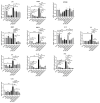Quercetin Ameliorates Lipopolysaccharide-Induced Duodenal Inflammation through Modulating Autophagy, Programmed Cell Death and Intestinal Mucosal Barrier Function in Chicken Embryos
- PMID: 36552443
- PMCID: PMC9774289
- DOI: 10.3390/ani12243524
Quercetin Ameliorates Lipopolysaccharide-Induced Duodenal Inflammation through Modulating Autophagy, Programmed Cell Death and Intestinal Mucosal Barrier Function in Chicken Embryos
Abstract
Diarrhea has been a global health problem for centuries, and the treatment has become increasingly difficult duo to the antibiotics overuse and resistance. Quercetin is a common flavonoid of extracts of vegetables, fruits, and traditional Chinese herbs, however, the mechanism of quercetin alleviating LPS-induced duodenal inflammation remains elusive. Specific pathogen-free chicken embryos (n = 120) were allocated to groups including control, PBS with or without alcohol, LPS (125 ng/egg) with or without quercetin (10, 20, or 40 nmol/egg, respectively), and quercetin groups (10, 20, or 40 nmol/egg). Fifteen day-old embryonated eggs were inoculated with abovementioned solutions via the allantoic cavity. At embryonic day 19, the duodena of the embryos were collected for histopathological examination, RNA extraction and real-time polymerase chain reaction, immunohistochemical investigations, and Western blotting. The results demonstrated quercetin enhanced the inflammatory cell infiltration in the Peyer's patch of the intestinal mucosa after LPS induction. The LPS-induced expressions of these inflammation-related factors (TLR4, IL-1β, MMP3, MMP9, NFKB1, IFNγ, IL-8, IL-6) were completely blocked by quercetin. Quercetin also decreased the protein expression of TLR4, IL-1β, MMP3, and MMP9 after LPS induction. Quercetin could down-regulate autophagy gene expression (ATG5, LC3-1, LC3-2, and LKB1), and decreased the protein expression of ATG5, and LC3-1/LC3-2 after LPS induction. Quercetin treatment prevented LPS-induced increases of the gene expressions of programmed cell death factors (TNFα, Fas, CASP1, CASP3, CASP12, Drp1, and RIPK1); meanwhile, quercetin decreased the protein expression of CASP1 and CASP3 after LPS challenge. LPS reduced the gene expression of mucin 2, but upregulated the mRNA and protein expression of claudin 1, occludin, and ZO-1, and this was balanced by quercetin. This evidence suggests that quercetin can alleviate duodenal inflammation induced by LPS through modulating autophagy, programmed cell death, intestinal barrier function.
Keywords: Traditional Chinese Medicine; autophagy; diarrhea; intestinal mucosal barrier function; programmed cell death; quercetin.
Conflict of interest statement
The authors declare no conflict of interest.
Figures





















Similar articles
-
Quercetin Alleviates Inflammation and Energy Deficiency Induced by Lipopolysaccharide in Chicken Embryos.Animals (Basel). 2023 Jun 21;13(13):2051. doi: 10.3390/ani13132051. Animals (Basel). 2023. PMID: 37443849 Free PMC article.
-
Quercetin Alleviates Lipopolysaccharide-Induced Cardiac Inflammation via Inhibiting Autophagy and Programmed Cell Death.Biomed Environ Sci. 2024 Jan 20;37(1):54-70. doi: 10.3967/bes2024.006. Biomed Environ Sci. 2024. PMID: 38326721
-
Quercetin attenuates lipopolysaccharide-induced hepatic inflammation by modulating autophagy and necroptosis.Poult Sci. 2024 Jun;103(6):103719. doi: 10.1016/j.psj.2024.103719. Epub 2024 Apr 2. Poult Sci. 2024. PMID: 38603936 Free PMC article.
-
Quercetin Alleviates Lipopolysaccharide-Induced Cell Damage and Inflammation via Regulation of the TLR4/NF-κB Pathway in Bovine Intestinal Epithelial Cells.Curr Issues Mol Biol. 2022 Oct 27;44(11):5234-5246. doi: 10.3390/cimb44110356. Curr Issues Mol Biol. 2022. PMID: 36354668 Free PMC article.
-
Canna x generalis L.H. Bailey rhizome extract ameliorates dextran sulfate sodium-induced colitis via modulating intestinal mucosal dysfunction, oxidative stress, inflammation, and TLR4/ NF-ҡB and NLRP3 inflammasome pathways.J Ethnopharmacol. 2021 Apr 6;269:113670. doi: 10.1016/j.jep.2020.113670. Epub 2020 Dec 8. J Ethnopharmacol. 2021. PMID: 33301917
Cited by
-
A detailed overview of quercetin: implications for cell death and liver fibrosis mechanisms.Front Pharmacol. 2024 May 23;15:1389179. doi: 10.3389/fphar.2024.1389179. eCollection 2024. Front Pharmacol. 2024. PMID: 38855739 Free PMC article. Review.
-
Quercetin Alleviates Inflammation and Energy Deficiency Induced by Lipopolysaccharide in Chicken Embryos.Animals (Basel). 2023 Jun 21;13(13):2051. doi: 10.3390/ani13132051. Animals (Basel). 2023. PMID: 37443849 Free PMC article.
-
Genetic Foundation of Male Spur Length and Its Correlation with Female Egg Production in Chickens.Animals (Basel). 2024 Jun 13;14(12):1780. doi: 10.3390/ani14121780. Animals (Basel). 2024. PMID: 38929399 Free PMC article.
References
-
- Troeger C., Blacker B.F., Khalil I.A., Rao P.C., Cao S.J., Zimsen S.R.M., Albertson S., Stanaway J.D., Deshpande A., Brown A., et al. Estimates of the global, regional, and national morbidity, mortality, and aetiologies of diarrhoea in 195 countries: A systematic analysis for the Global Burden of Disease Study 2016. Lancet Infect. Dis. 2018;18:1211–1228. doi: 10.1016/S1473-3099(18)30362-1. - DOI - PMC - PubMed
Grants and funding
LinkOut - more resources
Full Text Sources
Research Materials
Miscellaneous

